Biology:Whistling duck
| Whistling ducks | |
|---|---|
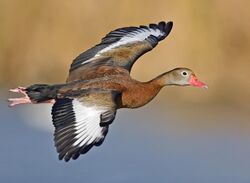
| |
| Black-bellied whistling duck | |
| Scientific classification | |
| Domain: | Eukaryota |
| Kingdom: | Animalia |
| Phylum: | Chordata |
| Class: | Aves |
| Order: | Anseriformes |
| Family: | Anatidae |
| Subfamily: | Dendrocygninae Reichenbach, 1850 |
| Genus: | Dendrocygna Swainson, 1837 |
| Type species | |
| Anas arcuata Horsfield, 1824
| |
The whistling ducks or tree ducks are a subfamily, Dendrocygninae, of the duck, goose and swan family of birds, Anatidae. In other taxonomic schemes, they are considered a separate family, Dendrocygnidae. Some taxonomists list only one genus, Dendrocygna, which contains eight living species, and one undescribed extinct species from Aitutaki of the Cook Islands, but other taxonomists also list the white-backed duck (Thalassornis leuconotus) under the subfamily.
Taxonomy and evolution
Whistling ducks were first described by Carl Linnaeus in the 10th edition of Systema Naturae in 1758: the black-bellied whistling duck (then Anas autumnalis) and the West Indian whistling duck (then Anas arborea).[1] In 1837, William John Swainson named the genus Dendrocygna to distinguish whistling ducks from the other waterfowl.[2] The type species was listed as the wandering whistling duck (D. arcuata), formerly named by Thomas Horsfield as Anas arcuata.[3]
Whistling duck taxonomy, including that of the entire order Anseriformes, is complicated and disputed.[4] Under a traditional classification proposed by ornithologist Jean Théodore Delacour based on morphological and behavioral traits,[5][6] whistling ducks belong to the tribe Dendrocygnini under the family Anatidae and subfamily Anserinae.[6][7] Following the revisions by ornithologist Paul Johnsgard, Dendrocygnini includes the genus Thalassornis (the white-backed duck) under this system.[7][8]
In 1997, Bradley C. Livezey proposed that Dendrocygna were a separate lineage from Anserinae, placing it and its tribe in its own subfamily, Dendrocygninae. Alternatively Charles Sibley and Jon Edward Ahlquist recommended placing Dendrocygna in its own family, Dendrocygnidae, which includes the genus Thalassornis.[6][7]
|
|
Species
Eight species of whistling duck are currently recognized in the genus Dendrocygna. However, Johnsgard considers the white-backed duck (Thalassornis leuconotus) from Africa and Madagascar to be distinct ninth species,[13] a view first proposed in 1960 and initially supported by behavioral similarities. Later, similarities in anatomy, duckling vocalizations, and feather proteins gave additional support.[8] Molecular analysis in 2009 also suggested that the white-backed duck was nested within the whistling duck clade.[12] In addition to the extant species, subfossil remains of an extinct, undescribed species have been found on Aitutaki of the Cook Islands.[14]
| Common name | Scientific name [lower-alpha 1] | IUCN Red List Status | Distribution | Picture | ||
|---|---|---|---|---|---|---|
| Status | Trend | Population[lower-alpha 2] | ||||
| West Indian whistling duck | Dendrocygna arborea (Linnaeus, 1758) |
6,000 - 15,000 | 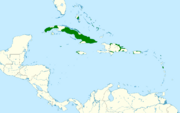
|

| ||
| Wandering whistling duck | Dendrocygna arcuata (Horsfield, 1824) |
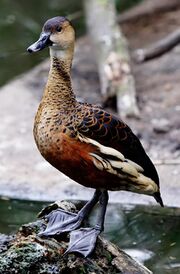
| ||||
| Black-bellied whistling duck | Dendrocygna autumnalis (Linnaeus, 1758) |
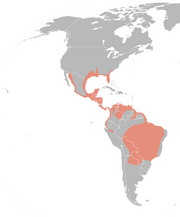
|

| |||
| Fulvous whistling duck | Dendrocygna bicolor (Vieillot, 1816) |
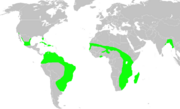
|
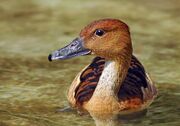
| |||
| Plumed whistling duck | Dendrocygna eytoni (Eyton, 1838) |

| ||||
| Spotted whistling duck | Dendrocygna guttata Schlegel, 1866 |
6,700 - 17,000 | 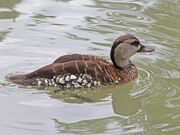
| |||
| Lesser whistling duck | Dendrocygna javanica (Horsfield, 1821) |
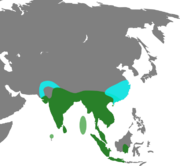
|
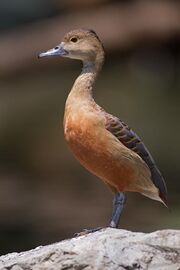
| |||
| White-faced whistling duck | Dendrocygna viduata (Linnaeus, 1766) |
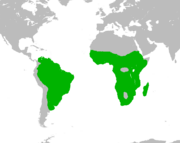
|
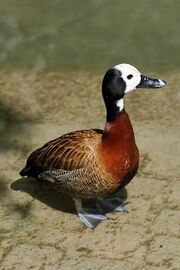
| |||
Description
Whistling ducks are found in the tropics and subtropics. As their name implies, they have distinctive whistling calls.[citation needed]
The whistling ducks have long legs and necks, and are very gregarious, flying to and from night-time roosts in large flocks. Both sexes have the same plumage, and all have a hunched appearance and black underwings in flight.[citation needed]
After breeding and pairing with a female, male whistling ducks (especially within the Fulvous whistling duck species) will often help with the construction of nests and will take turns with the female incubating the eggs.
Notes
- ↑ A binomial authority in parentheses indicates that the species was originally described in a genus other than Dendrocygna.
- ↑ Estimate for the number of mature individuals in the wild.
References
- ↑ Linnaeus 1758, p. 127–128.
- ↑ Swainson 1837, p. 365.
- ↑ Eyton 1838, p. 28.
- ↑ Donne-Goussé, Laudet & Hänni 2002, p. 339.
- ↑ Johnsgard 1965, p. 14.
- ↑ 6.0 6.1 6.2 Donne-Goussé, Laudet & Hänni 2002, pp. 340.
- ↑ 7.0 7.1 7.2 Donne-Goussé, Laudet & Hänni 2002, pp. 353–354.
- ↑ 8.0 8.1 Johnsgard 2010b, p. 26.
- ↑ Donne-Goussé, Laudet & Hänni 2002, p. 348.
- ↑ Gonzalez, Düttmann & Wink 2009, p. 313.
- ↑ Pereira & Baker 2009, p. 416.
- ↑ 12.0 12.1 Eo, Bininda-Emonds & Carroll 2009, pp. 471–472.
- ↑ Johnsgard 2010a, p. 41.
- ↑ Steadman 2006, pp. 213 & 218.
Literature cited
- Donne-Goussé, C.; Laudet, V.; Hänni, C. (2002). "A molecular phylogeny of anseriformes based on mitochondrial DNA analysis". Molecular Phylogenetics and Evolution 23 (3): 339–356. doi:10.1016/S1055-7903(02)00019-2. PMID 12099792.
- Eo, S.H.; Bininda-Emonds, O.R.P.; Carroll, J.P. (2009). "A phylogenetic supertree of the fowls (Galloanserae, Aves)". Zoologica Scripta 38 (5): 465–481. doi:10.1111/j.1463-6409.2008.00382.x. http://www.molekularesystematik.uni-oldenburg.de/download/Publications/fowlSupertree.pdf.
- Eyton, T.C. (1838). A Monograph on the Anatidae Or Duck Tribe. London: Longman, Orme, Brown, Green, & Longman. pp. 183. doi:10.5962/bhl.title.51971. https://www.biodiversitylibrary.org/item/111070#page/11/mode/1up.
- Gonzalez, J.; Düttmann, H.; Wink, M. (2009). "Phylogenetic relationships based on two mitochondrial genes and hybridization patterns in Anatidae". Journal of Zoology 279 (3): 310–318. doi:10.1111/j.1469-7998.2009.00622.x.
- Johnsgard, P.A. (1965). "Tribe Dendrocygnini (Whistling Ducks)". Handbook of Waterfowl Behavior. Ithaca: Cornell University Press. pp. 378. http://digitalcommons.unl.edu/bioscihandwaterfowl/10.
- Johnsgard, P.A. (2010a). "Whistling Ducks: Tribe Dendrocygnini". Waterfowl of North America, Revised Edition. Lincoln: University of Nebraska–Lincoln Libraries. pp. 575. http://digitalcommons.unl.edu/biosciwaterfowlna/17/.
- Johnsgard, P.A. (2010b). "Tribe Dendrocygnini (Whistling or Tree Ducks)". Ducks, Geese, and Swans of the World. Lincoln: University of Nebraska–Lincoln Libraries. pp. 404. http://digitalcommons.unl.edu/biosciducksgeeseswans/4/.
- Linnaeus, C. (1758). Systema Naturæ. 1 (Tenth ed.). Stockholm, Sweden: Laurentius Salvius. pp. 825. https://www.biodiversitylibrary.org/page/726922#page/146.
- Pereira, S.L.; Baker, A.J. (2009). "Waterfowl and gamefowl (Galloanserae)". in Hedges, S.B.; Kumar, S.. The Timetree of Life. Oxford: Oxford University Press. pp. 576. ISBN 978-0-19-160898-8. http://www.timetree.org/pdf/Pereira2009Chap59.pdf.
- Steadman, D.W. (2006). Extinction and Biogeography of Tropical Pacific Islands Birds. Chicago: University of Chicago Press. pp. 594. ISBN 0-226-77142-3. https://books.google.com/books?id=vBZXJQ3HDg0C&pg=PA213.
- Swainson, W. (1837). On the Natural History and Classification of Birds. 2. London: Longman, Rees, Orme, Brown, Green & Longman. pp. 398. https://books.google.com/books?id=goJIAAAAYAAJ&pg=PA365.
External links
Wikidata ☰ Q1006681 entry
 |

